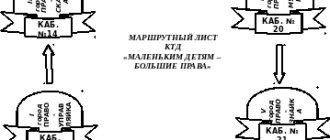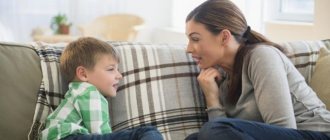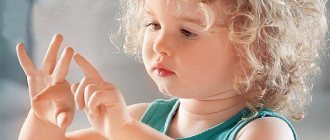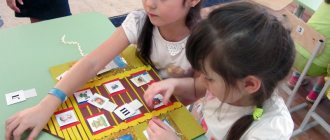The use of this part of the subject-development environment is aimed at:
- development of discipline and the ability to complete what is started;
- improving attention, thought processes, imagination and speech skills;
- recording acquired knowledge and skills;
- developing the ability to work in a team, friendliness and cooperation.
The use of games allows us to identify children’s areas of interest, determining their preferences during play. A variety of material teaches preschoolers to generalize objects according to a certain characteristic, to distinguish them from each other depending on their use and purpose. Also, during the game, the child notices the relationships between objects and learns to form a whole from the resulting parts.
An important point in the game is the need to choose a partner for interaction and find your place in the group. Children are divided into pairs or triplets, and a large number of students in the group significantly complicates the task.
The teacher plays the role of a guide in the game; he pushes the children to take the right actions, rather than directing the process. Also, do not forget about praising and encouraging the success of preschoolers.
The card index of printed board games for children aged 5-6 years old, used in kindergarten, includes the following materials:
- domino;
- checkers;
- puzzles with different numbers of pieces;
- pictures made up of cubes, the pattern on the edges of which relates to a specific image;
- mosaics;
- didactic games in pictures.
The use of games affects visual perception, which is an important element of the educational process in preschool educational institutions. To include printed pedagogical material in children’s activities, it is necessary to remember that the principle of visualization implies the presence of a visual example. That is, in order to assemble the puzzle, the child will need the original whole picture as an example.
Visual perception is developed by games such as mosaics, cards with images of animals and plants, and plot pictures. For the same purpose, teaching materials are included in the work in the form of a field map with a set of chips and cubes.
Didactic games for children 4-5 years old in kindergarten
Printed board games for children 4-5 years old
Paired pictures
Didactic task. Develop observation skills in children; the ability to find similarities and differences in objects depicted in pictures; activate children's vocabulary: similar, different, identical.
Game rule. Select only identical pictures. The one who doesn't make a mistake wins.
Game action. Search for identical pictures.
Progress of the game . Children sit at a table on which pictures are laid out. There are many of them (10-12), they are all different, but among them there are two identical ones. The teacher asks one of the children to find and name identical pictures and show them to everyone playing. Paired pictures are put aside. Then the teacher mixes all the pictures (they must be upside down) and quietly adds another paired picture. Having laid them out on the front side, he again offers to find the same ones. The difficulty lies in the fact that among the cards there can be very similar, but not the same, for example: cups, identical in color and shape, but one with a handle and the other without a handle; two apples are the same, but one has a stem and the other does not, that is, they have subtle signs of difference that children do not immediately notice.
The game is played with a small group of children so that all the children sit on one side of the table and everyone can clearly see the pictures. To complicate the game, you can offer to find not just one pair, but several pairs of identical pictures. Children talk about objects, note how they are similar and how they are different.
Who's doing what
Didactic task. Clarify and consolidate children’s knowledge about agricultural work; develop thinking, ingenuity, concentration, desire to play with peers.
Game rule. Collect from individual parts a whole picture by type of agricultural labor: a tractor driver plows the land, a combine operator harvests grain, milkmaids milk cows, a cattleman cares for animals, a poultry worker feeds chickens, collective farmers weed a field, etc.
Game actions. Search for the necessary parts of the picture; a story about the type of labor depicted in the resulting whole picture. Competition - who will be the first to put together a picture.
Progress of the game. The game begins with a short conversation about agricultural work, during which children remember different professions and machines that help rural workers in their work. Then the teacher reminds the rules of the game learned earlier in other games with pictures. The complication in this game is that the number of parts increases to 10 - 12.
Here you need to be even more attentive and smart. The one who puts the picture together first wins. He receives a winner badge, such as a star.
Make no mistake!
Didactic task. Clarify and consolidate children’s knowledge about different sports; cultivate a desire to play sports, develop resourcefulness, intelligence, and attention.
Game rule. The winner is the one who is the first to put together a picture (of six parts) about one sport.
Game actions . Finding the necessary parts of the picture, putting them together; competition.
Progress of the game . The teacher has cards depicting various sports: football, hockey, volleyball, gymnastics, rowing. The game is played according to the type of cut pictures, but they are cut differently - in the middle there is a picture with an athlete. It is necessary to select for the athlete everything necessary for the game. Whoever completes the whole picture first wins.
Using this principle, you can make a game in which children will select tools for different professions. For example, a builder: pick up all the tools he needs for work - a shovel, trowel, paint brush, bucket; machines that facilitate the work of a builder - a crane, excavator, dump truck, etc.
The pictures depict people of those professions that children are introduced to throughout the year: cook, janitor, postman, salesman, doctor, teacher, builder, tractor driver, mechanic, etc. Images of the objects of their labor are selected for them. The correctness of execution is controlled by the picture itself: from small pictures it should turn out to be a large, whole one.
Domino
Didactic task. To consolidate children’s knowledge about means of transportation: cars, trains, planes, helicopters, ships, boats, and note their features; continue to develop the ability to play together and obey the rules of the game.
Game rules . The winner is the one who finishes the selection of pictures first, puts them according to the rule: plane to plane, car to car, boat to boat - and never makes a mistake; he receives a chip - a red circle.
Game actions . Finding the right pictures, maintaining the order.
Progress of the game . For this game you need to make cards, like in any game like Dominoes. The card is divided into two halves: each of them depicts different types of transport. The game is designed for 4-6 participants. There should be 24 cards. If there are four players, 6 cards are dealt. The game is played like a Domino game. The one who puts down the last card, while others still have them, wins and gets a chip. When the game is repeated, the cards are shuffled. Children count out 4-6 cards without looking, and the game continues.
Lotto
Didactic task. Systematize children’s scattered knowledge about transport, pioneers, school, pets, and family; activate children's speech, practice the correct naming of objects, use general words: transport, pets, school, family, pioneers.
Game rule . Correctly select objects and cover cells with them on large maps that depict a city street, a pioneer camp, a family, a school, or pets.
Progress of the game . Children take the cards themselves. They choose a driver, at whose signal everyone begins to quickly look for small cards and cover the cells with them. Whoever closes all the cells first wins and gets a chip.
The game is repeated several times, with the cards changing. At the end of the game they count: whoever has more chips wins. The teacher does not forget to remind the children to put all the pictures in the box and put it back in its place.
Hunter and shepherd
Didactic task . Exercise children in grouping wild animals and domestic animals; learn to correctly use generalizing words wild animals, domestic animals; cultivate attention and speed of reaction to words.
Game rules . Select and place on the flannelgraph only those pictures that the hunter or shepherd needs (see figure). Whoever selects all the pictures first wins.
Game actions . Search for the required pictures; competition; use of flannelgraph.
Progress of the game. The teacher explains the rules of the game:
— Today we have a new interesting game. It's called "Hunter and Shepherd". Who is a hunter? Who knows? (Children answer.) Yes, he hunts in the forest. Remember what wild animals you know.
“Hare, fox, wolf, bear, squirrel, tiger,” the children list.
- Why are they called wild? - the teacher asks the children. - Right. Because they live in the forest, far from a person's home. So who hunts wild animals?
“Hunter,” the children answer in unison.
-Who is the shepherd? - the teacher asks the question again. - What animals does he graze?
The children answer, the teacher asks all the children to say in chorus the words domestic animals and wild animals.
- So, the shepherd grazes domestic animals, and the hunter hunts wild animals. Now we will choose a shepherd and a hunter for the game. Who wants to be a hunter? And who is the shepherd? (To begin with, he chooses children who are more active.) Vitya is a shepherd, and Zhenya is a hunter. Fine. Now listen to the rules of the game: on this half of the flannelgraph, on the right there is a meadow where domestic animals graze, and on the left side there is a forest where wild animals live.
At the signal “Look!” Vitya and Zhenya will take and put pictures of animals on the flannelgraph. And you, children, keep an eye on them to see if the pictures are selected correctly. If someone makes a mistake, it means he is a bad shepherd or hunter.
The shepherd and the hunter come to the table. "Look!" - the teacher gives a signal. For the first time you should put a small number of animal species (4-5), next time you need to add 2-3 more species to complicate the task.
At the end of the game you can count how many wild animals and how many domestic animals. In the game, there should be an equal number of cards with images of wild animals and domestic animals.
What's extra?
Didactic task . Teach children to notice errors in the use of objects; develop observation skills, a sense of humor, and the ability to prove the correctness of one’s judgment; consolidate knowledge about working tools.
Game rule . Cover with cardboard only the picture that is unnecessary. The first one to discover the unwanted item wins.
Game actions. Find and close unnecessary items.
Progress of the game . People of different professions are drawn on large maps, and in the cells are the objects and tools they need for work. Among them there are those who are not needed for this profession. For example, in the center there is a drawing that depicts a nurse treating a patient, and in the cells are drawn all the objects necessary for her work, including dumbbells.
Children playing should notice and cover the unnecessary object with a clean square. Here you need to select pictures with professions familiar to children: cook, janitor, driver, combine operator, builder, teacher, salesman, etc. Children exchange cards and the game continues.
When does this happen?
Didactic task . Strengthen children's knowledge about the parts of the day; exercise them in comparing pictures with parts of the day: morning, afternoon, evening, night.
Game rules . According to the word that the teacher says, show the card and explain why he picked it up.
Game action. Search for the desired picture.
Progress of the game. On the table the players have different pictures reflecting the life of children in kindergarten: morning exercises, breakfast, classes, games in the area, sleep, cleaning the group room, sledding, parents coming, etc. There should be several scenes of pictures for each part of the day. Children each choose any picture for themselves and look at it carefully. When they hear the word morning, all the children raise the picture and each one explains why he thinks it is morning: the children come to kindergarten, the teacher is waiting for them, they do morning exercises, wash, brush their teeth, have breakfast, study, etc. Then the teacher says word day. Pictures are raised by those who have an image of some event or activity of children at this time of day: on a walk, working on the site, having lunch, sleeping. “Evening,” says the teacher, and the children raise the corresponding cards.
- Why did you show this card? - asks the teacher of the summoned child.
“Because the mothers came for the children, it’s dark outside,” he answers.
“Night,” says the teacher, and the children pick up cards with pictures of sleeping children.
This strengthens children’s knowledge about the parts of the day. For each correct answer, children receive chips: pink chip - morning, blue - day, gray - evening, black - night.
Then all the cards are shuffled, and the game continues so that the words are called in the reverse order: the teacher says, for example, evening, and then morning, i.e., thereby increasing attention to the verbal signal.
Where can I buy this?
Didactic task . To consolidate children’s knowledge that different goods are sold in different stores: grocery stores, department stores, bookstores (there are different grocery stores: “Vegetables and Fruits,” “Bakery,” “Milk”; department stores: “Shoes,” “Clothing,” “ Fabrics", "Children's World", "Sports Store"); teach children to distinguish stores according to their purpose, to navigate their surroundings; cultivate a desire to help parents make simple purchases.
Game rule. Match the items shown in the small pictures with the names of the stores on the large cards. The game is played according to the “Loto” type. The one who makes no mistakes and is the first to cover all the squares wins.
Game actions. Search, find pictures, cover the cells with them. Competition.
Progress of the game. At the beginning of the game, the teacher conducts a conversation with the children about whether they know where their mothers buy food, necessary things, items, what stores they know, what are the names of the stores that are close to their home, do they help their parents buy bread , milk and other products. After the conversation, the teacher shows large maps on which different stores are drawn. Children learn from store windows what is sold there (some children can read the words bread, milk).
- Now, children, let's play. I will give you small cards, and then you have to say where, in which store you can buy it, bring the card and put it on the big card, to the store where you can buy it. Take your time, look carefully at the picture!
Having distributed the cards, the teacher gives the signal: “Start the game!” Children come to the table and place their cards on the squares of a large map. Where the “Milk” store is depicted, cards are placed with images of bottles, packages of milk, cheese, butter, sour cream, cottage cheese, etc. The teacher checks the correctness of the children’s actions and rewards those who correctly found the right store.
The game helps children learn that everything people need is bought in stores; there are different stores.
You need to know which store is near your home in order to help your parents make simple purchases. Pages: 2
Monopoly Junior (Ozon, My-shop, KoroBoom)
Yes, yes, that same Monopoly. An all-time hit to introduce children to this global bestseller early, a caring manufacturer has developed a lightweight version of the game for younger children - Monopoly Junior. And in general, I think he did it for good reason, because children 4 years old and older really play it with great pleasure.
The game is known for teaching children business thinking. Perhaps this is a bit loudly said, but, nevertheless, Monopoly gives some understanding about land rental and investment. The child sees with his own eyes that money invested now can bring constant income later.
Main differences from the classic “adult” version:
- There are fewer cells and, accordingly, fewer enterprises that can be purchased for your own.
- A simplified mechanism is provided for installing branches in enterprises and calculating profits from them.
- All banknotes do not exceed 1 mono-ruble in value, which is designed specifically for children who do not yet know how to perform mathematical operations with large numbers. In fact, it seemed to me that the developer overdid the simplification here. Counting ruble bills is a little tiring, and a child of this age could easily be trusted to count at least within 5, including banknotes of 2 and 3 denominations. This would also be useful.
Fishing cat (Labyrinth, KoroBoom)
There are board games that you can already tell when you buy them how much your child will like them. But it also happens that the game does not live up to expectations at all. Moreover, sometimes pleasant surprises happen - you don’t expect anything special from the game, but then boom, it goes off! This is exactly what happened to us with “Fisher Cat”.
The game is quite compact, and that’s why I once took it with me to a tourist gathering. There were quite a few children of different ages there, and I thought that between the barbecue and picking at the lake with sticks, the game should come in very handy. However, I did not expect SUCH success. The children, like the most avid gamblers, played “Fisher Cat”, almost without stopping. Undoubtedly, we can say that half of success is a successful company and a good mood. This is true. But the game is really great for playing independently in a small group of children. It is a competition for dexterity and speed of reaction, which means excitement is guaranteed! The rules of the game are extremely simple.
Having tried “The Fishing Cat” on the road, we continued the wonderful tradition of fun fishing at home. The only thing is that it’s better to play this game with a group of 3-4 people; it won’t be very interesting for two people.
For some reason they stopped producing a version of the game like ours (produced by Step-Puzzle), but here is a similar game from another company.
Turtle racing (Ozon, My-shop, KoroBoom)
At first glance, you might think that this is the most ordinary walker with turtles, but it is not so! I will list a few differences that make the game quite unusual and interesting.
Firstly, initially the participants do not know who is playing for which turtle; only the player himself knows about this.
Secondly, each player can move any turtle in any direction if the cards allow him to do so. You can move both your own and your opponent’s turtle.
And thirdly, the most fun thing is that turtles can climb on each other’s backs. This means that you can climb onto your opponent’s back and ride it almost to the finish line. The main thing is to get off on time
In this game you will have to not just walk mindlessly, but think a little, thinking through a certain strategy (whose back to climb on, whose turtle to resemble, etc.). This, of course, is not easy for children right away, but little by little, as they gain experience, they begin to act more thoughtfully.
Activities for children (Ozon, My-shop, KoroBoom)
Another board for chatterboxes But it will, of course, also be useful for those children who are not so talkative and need to develop their speech skills. In other words, everyone will like the game
You may already be familiar with the original version of Activity, it is quite popular in adult companies. My friends and I also used to play it for hours until we got sick. For those who are hearing about this game for the first time, I will briefly describe the essence. Here, as in the well-known game “Crocodile,” you need to explain the words to each other. Only if in “Crocodile” this is always done with gestures, then in Activity they also use spoken language and drawings. The way of explanation changes every time. True, because of our daughter’s great love for drawing, we often change the rules and allow her to express herself with drawings more often than required
If, as a result of the move, the word was successfully guessed and solved, then the team can move its elephant figurine forward. The winner, naturally, is the team whose bishop gets to the finish line faster.
Since we play board games most often as a family (the three of us), a big disadvantage for us is that the minimum number of participants in the game is 4 people (2 in each team). We have to play the family team against the toy team. Of course, we too act as toys. You can also play with one single team against time. In general, we get out as best we can, we want to play
One more thing - I would like a little more difficult words on the cards. Even for a 5-year-old child, the explanation of many words seems quite simple. So you need to either start earlier, or come up with complications for the game
Cephalopods (Ozon, My-shop, KoroBoom)
I think you've already come across a whole host of small card games like this in small boxes in stores. So, “Cephalopods” is a very worthy representative of this darkness, you can definitely pay attention to it.
How is it usually? The game or reaction speed develops, or imagination, or memory. And here it’s all together at once! During the game, you will not only need to come up with funny names for the cephalopods, but remember them well, and also try to name them before the others. It turns out very funny and perky!
We laughed heartily. We had Grushenoses, Curlypups, and Surprisingly. You can call it whatever the appearance of the cephalopod suggests, or you can simply call it Ivan Ivanovich. The main thing is to remember these names later, and this is not an easy task!
Guess who (or analogue – “Who’s in the window”)
Dark? Or blonde? No, this is not a question for men about their preferences. This is one of those questions that will arise in a child’s head when he tries to identify the character you have in mind.
While some board games develop dexterity, others develop speech, this one is aimed at developing analytical thinking and the ability to categorize information. Moreover, here the child is required not only to guess something based on logical conditions, but also to formulate these logical conditions himself. During the game, the child learns to ask questions in such a way as to quickly weed out all unsuitable candidates - “Is this a man?”, “Is he wearing glasses?”, “Is he bald?”
To make the exclusion of unsuitable characters more clear, the game has special windows that close. In the end, only one hero should remain uncovered - the one that the opponent wished for.
I will say right away that at first it will not be easy for the child. He will ask a lot of duplicative and suboptimal questions, which will bring him almost no closer to victory. But gradually he will learn to set the conditions correctly, and this is the beauty of the game.
We had the original board game from Hasbro - “Guess Who?”, it had only two game options - guessing people and animals. Now there are analogues that are almost as good in quality, but at the same time contain more playing fields. For example, in the game “Who's in the Window”, in addition to people and animals, you can also choose a playing field with professions, vegetables and fruits.








